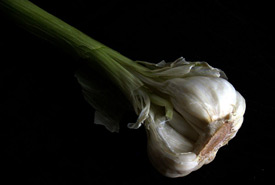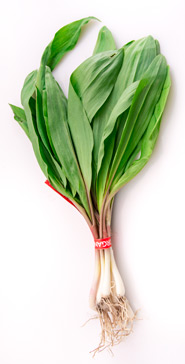Garlic: The forbidden fruit? (Part Two)

Garlic (Photo by cyclonebill/Wikimedia Commons)
Part One of this blog was an overview of garlic, and the native variety growing in the Eastern Townships and Outaouais regions in Quebec. In Part Two I present you with a little garlic 101!
The minimum threshold for a wild garlic population to sustain itself is 1,000 plants. Less than that, and the crop will struggle. It’s time to wake up and smell the garlic if we want to keep our kitchen favourite!
Garlic history past and present
Did you know that garlic goes as far back as the time of the Babylonians? Back then, garlic was a super important medicinal herb. It was used to remedy pretty much everything: intestinal worms, haemorrhoids, digestive issues, infections, skin rashes and diseases. Physicians of the Roman Empire called garlic a cure-all.
In 1665, during the Great Plague of London, the curious tale of the Four Criminals emerged: four thieves stole from the dead but survived infection by consuming a daily concoction of garlic and vinegar. This concoction is actually available today and is literally called Four Thieves’ Vinegar!
In more recent centuries, Louis Pasteur’s detailed texts on garlic’s antibacterial effects was distributed among western European physicians. Garlic was, and still is, used to treat many cardiovascular diseases and is found in dietary medications.

Wild garlic, a species found in eastern Canada and eastern U.S. (Photo by Wikimedia Commons)
Garlic also has vitally important cultural and religious uses. In some cultures, garlic is a powerful defense against evil beings. In others, garlic is an essential part of traditional rituals and celebrations.
Of course, if we talk about culinary uses, garlic is among the top 10 ingredients in almost every single culture and/or country. There is a recipe for every part of the garlic plant, except for the roots, which are the only inedible parts.
When, how and how much to harvest
Garlic is often compared with apples because both plants have so many different types. However, this comparison often leads people to think that the two plants also grow in the same way. This isn't the case. Apple trees flower and germinate annually, giving up fresh apples every autumn. Garlic plants, on the other hand, actually take up to seven summers after germination to produce flowers. And we're talking good summers with suitable weather conditions. It's only after the flowers have bloomed that the garlic bulbs are ready for harvest.
Garlic has a very short growing period, between mid-spring to early summer. Once the leaves above ground are done, the bulb can be ready to harvest. Harvesting essentially rips out the entire plant, including the roots, explaining why garlic crops need to be harvested sustainably to maintain their numbers.
Be a garlic guardian
There you have it: the importance of garlic in a brief clove-shell. If you’re a garlic enthusiast, hopefully you can love and appreciate garlic that much more. If you’re not a garlic lover, hopefully you can see the necessity of keeping garlic around for many more centuries.
If ever you happen to see suspicious garlic collectors in the daytime and especially at nighttime, please don’t hesitate to phone SOS BRACONNAGE (SOS Poaching) at 1 800 463-2191. Or, visit the website for Ministre de Développement durable, Environnemental et Lutte contre les changements climatiques http://www.mddelcc.gouv.qc.ca/index.asp.
If you’re in Montreal next August, come check out Le Festival de l’Ail (Garlic Festival) at Lalonde Park in Ste-Anne de Bellevue!
As for now, pass the garlic butter please!


